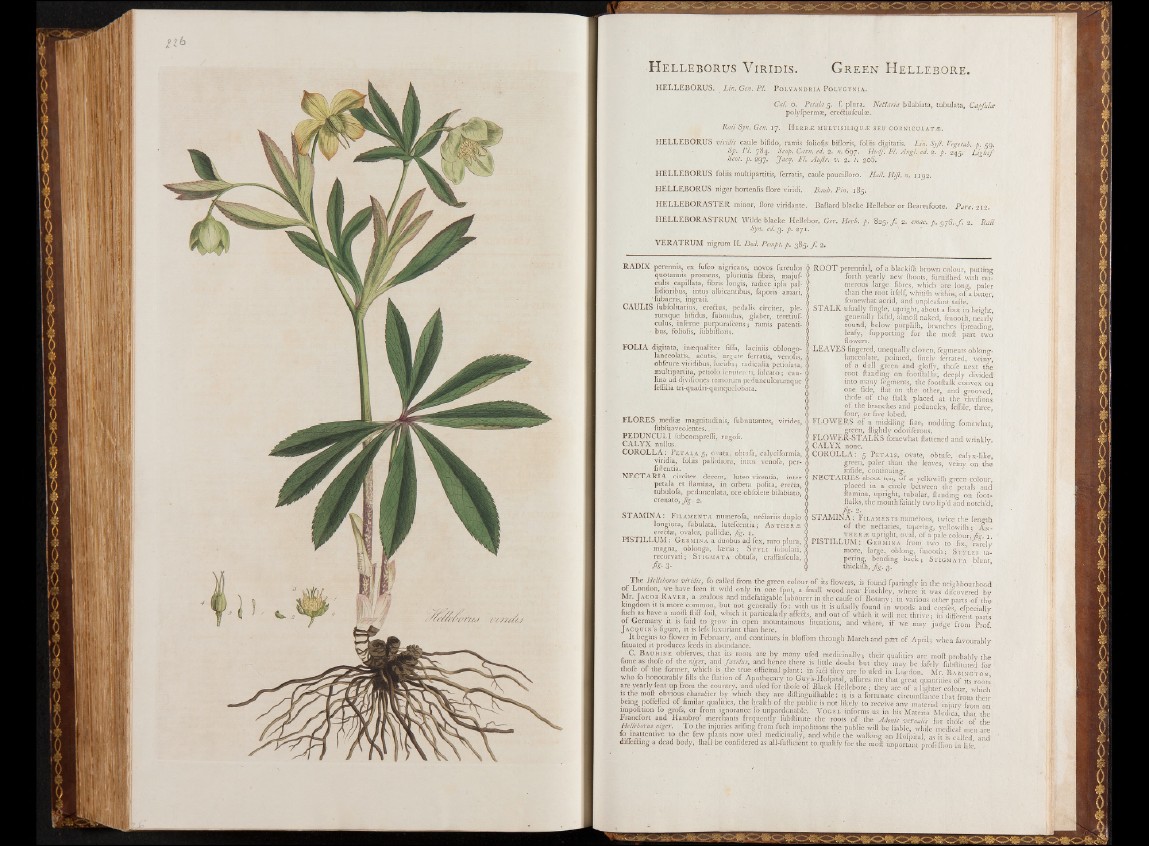
H elleborus Viridis. Green Hellebore.
HELLEBORUS. Lin. Gen. PI. Polyandria Po lygyn ia .
Cal. o. Petala g. f. plura. NeEiaria bilabiata, tubulata, Capfulce
polyfpermas, ereftiufculze.
Raii Syn. Gen. 17. Herb.« multusiliqu« seu corniculat« .
HELLEBORUS viridis caule bifido, ramis foliofis bifloris, foliis digitatis. Lin. Syft. Vegetal), p. gg.
Sp. PI. 784. Scop. Carn. ed. 2. n. 6 9 7 . Hudf. Fl. Angl. ed. 2. p. 245. Light/'
Scot. p. 297. Jacq. Fl. Aüßr. v. 2. t. zo5.
HELLEBORUS foliis multipartitis, ferratis, caule paucifloro.' Hall. Hiß. n. 1 19 2 .
HELLEBORUS niger hortenfis flore viridi. Bauh.Pin. 185.
HELLEBORASTER minor, flore viridante. Baftard blacke Hellebor or Bearesfoote. Pam. 212.
HELLEBORASTRUM Wilde blacke Hellebor. Ger. Herb. p. 825 . f . 2. emac. p. gqC.-f. 2. Raii
aSyn. ed. 3. p. 2/X. ^ r|
VERATRUM nigrum II. Dod. Pempt. p. 385. f . 2.
RADIX perennis, ex fufco nigricans, novos furculos
quotannis promens, plürimis fibris, majiif-
culis capillata, fibris Iongis, radice ipfa pal-
lidioribus, intus albiqmtibus, faporis amari,
’ fubacris, ingrati.
CAULIS fubfolitarius, ereßus, pedalis circiter, ple-
rumque bifidus, fubnudus, glaber, tere'tiuf-
culus, inferne puipurafcens; ramis patenti-
- bus, foliofis, fubbifloris.
FOLIA digitata, insequaliter fifla, laciniis oblongo-
lanceolatis, acutis,' argute ferratis, - venofis,
obfcure viridibus, Iucidis; radicaüa petiolata,
multipartita, petiolo femitereti, fulcato ; cau-
lina ad divifiones ramorum pedunculorumque
feflilia tri-quadri-quinquelöbata.
FLORES mediae magnitudinis, fubnutantes, virides,
fubfuaveolentes.. -
PEDUNCULI fubcompreffi, rugofi.
CA L YX nullus.
COROLLA: Petala 5, ovata, obtufa, calyciformia,
viridia, foliis pallidiora, intus venofa, per-
fiftentia.
NECTARIA circiter decern, luteo-virentia, inter
petala et ftamina, in orbem pofita, ere£la,
tubulofa, pedunculata, ore obfolete bilabiato,
crenato, fg . 2 ..
STAMINA: Filamenta numerofa, neßariis duplo
longiora, fubulata, lutefcentia; A nther.«
erectae, ovales, pallidae, fig. 1.
PISTILLUM: G ermin a a duo bus ad fex, raro plura,
magna^ ■ oblonga, laevia; St y l i fubulati,
recurvati; Stigmata obtufa, crafliufcula,
fig- 3-
| ROOT perennial, o fa blackifh brown colour, Putting
5 . forth yearly new (hoots,( furniihed with nuf
merous large fibres, which are long, paler
| than the root itfelf, whitifli within, of a bitter,
| fomewhat acrid, and unpleafant tafle.
| STA LK ufually (ingle, upright, about a foot in height,
® generally bifid, almoft naked, fmooth, nearly
0 round, below purplifh, branches fpreading,
s leafy, fupporting for the moft part two
| flowers.
5 LEAVES fingered, unequally cloven, fegments oblong-
lanceolate,' pointed, finely ferrated, veiny,
of a dull green and glofly, thofe next the
root (landing on footftalks, deeply divided
into many , fegments, the footftalk convex on
one fide, flat on the other, and grooved,
thofe of the (lalk placed at the divifions
of the branches and peduncles, feflile, three,
four, or five lobed.
FLOWERS of a middling fize, nodding fomewhat,
green, (lightly odoriferous. ■
FLOWER-STALKS fomewhat flattened and wrinklv.
CALYX none.
COROLLA: g Petals, ovate, obtufe, calyx-like,
green, paler than the leaves, veiny on the
mfide, Continuing.
NECTARIES about ten, of a yellowilh green colour,
placed in a circle between the petals and
(lamina, upright, tubular, (landing on footftalks,
the mouth faintly two lip’d and notch'd,
fig- 2.
STAMINA: Filaments numerous, twice the length
of the ne&aries, tapering, yellowifti • A nth
e r s upright, oval, of a pale colour, fig-. -
PISTILLUM: G ermin a from two to fix,
more, large, oblong, fmooth; STy:
pering, bending back; Stigmata
thickilh, fig. q.
rarel
es ta
bluni
The Helleioms mriiis, fo called from the green colour of its floirers, is found fparingly in the neighbourhood
of London, we have feen it wild only in one (pot, a fmall wood near Finchley, where it was discovered by
Mr. J a c o b R a y e r , a zealous and indefatigable labourer in the caufe o f Botany; in various other parts of the
kingdom it is more common but not generally fo: with us it is ufually found in woods and copies, efpecially
(uch as. have a mold (liff foil, which it particularly affeas, and out of which it will not thrive; in different parts
o f Germany it is (aid to grow in open mountainous fituations, and where, if we may judge from Prof
J a c q u i n ’s figure, it is lefs'luxuriant than here. 1 ‘ 1 J °
It. begins to flower in February,, and continues in bloflbm through March and part of April; when favourably
ntuated it produces feeds in abundance. • '
C. B a u h in e obferves, that its roots are by many ufed medicinally; their qualities are moft probably the
lame as thole of the niger, and fetidus, and hence there is little doubt but they may be fafely fubftituted for
thofe of the former, which is the true officinal plant: in faQ they are fo ufed in London. Mr B a b i n g t o n
who fo honourably fills the ftation of Apothecary to Guy s-Hofpital, aflures me that great quantities of its roots
are yearly fent up from the country, and ufed for thofe of Black Hellebore ; they are of a bo-hter colour which
is the moft obvious charaaer by which they are diftinguifliable: it is a fortunate circumftance that from their
being poiidled of hmilar qualities, the health of the public is not likely to receive any material injury from an
imppfition fo grofs, or from ignorance fo unpardonable. V o g e l informs us in his Materia Medica^ that the
Francfort and Hambro’ merchants frequently fubftitute the roots pf the Adonis vernalis for thofe of the
Helleborus niger. To .the injuries anfing from fuch impofitions the public will be liable, while medical men are
fo inattentive to. the few plants now tiled medicinally, and while the walking an Hofpital as it is called and
difleaing a dead body, (hall be confidered as all-fufficient to.qualify for the molt important profeffion in life